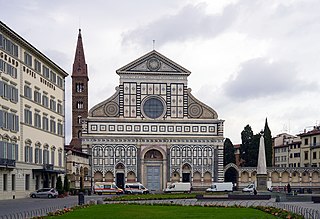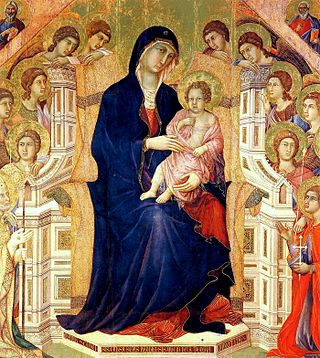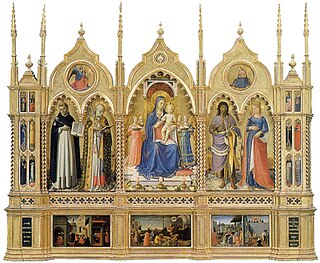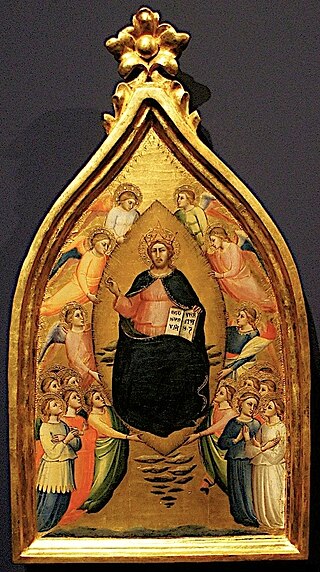
Santa Maria Novella is a church in Florence, Italy, situated opposite, and lending its name to, the city's main railway station. Chronologically, it is the first great basilica in Florence, and is the city's principal Dominican church.

Duccio di Buoninsegna, commonly known as just Duccio, was an Italian painter active in Siena, Tuscany, in the late 13th and early 14th century. He was hired throughout his life to complete many important works in government and religious buildings around Italy. Duccio is considered one of the greatest Italian painters of the Middle Ages, and is credited with creating the painting styles of Trecento and the Sienese school. He also contributed significantly to the Sienese Gothic style.

Pietro Lorenzetti or Pietro Laurati was an Italian painter, active between c. 1306 and 1345. Together with his younger brother Ambrogio, he introduced naturalism into Sienese art. In their artistry and experiments with three-dimensional and spatial arrangements, the brothers foreshadowed the art of the Renaissance.

Lippo Memmi was an Italian painter from Siena. He was the foremost follower of Simone Martini, who was his brother-in-law.

San Francesco della Vigna is a Roman Catholic church in the Sestiere of Castello in Venice, northern Italy.

Santa Caterina d'Alessandria is a Gothic-style Roman Catholic church in Pisa, Tuscany, Italy.

Lorenzo di Bicci was an Italian painter of the Florentine School considered to be one of the most important painters in Florence during the second half of the 14th century. He is believed to have learned his trade from his father, about whom little is known. Lorenzo’s style, as well as that of his contemporaries Jacopo di Cione and Niccolò di Pietro Gerini, was influenced by the artist Andrea di Cione. Lorenzo's paintings made use of bright colors and his compositions avoided complexity. The figures he painted tended to have round faces and were often expressionless. Another one of Lorenzo's distinctive characteristics was his precision of execution. He was known for exceptional talent in drawing, an ability that he put to use at the initial stages of his painting. Unlike many celebrated Florentine artists of this period, Lorenzo mostly received commissions from the country clergy and from the lower-middle-class Florentine guilds. His successors, Bicci di Lorenzo and Neri di Bicci, continued to serve these groups.
Andrea Vanni was an Italian painter of the early Renaissance, active mainly in his native Siena.

The Stefaneschi Altarpiece is a triptych by the Italian painter Giotto, from c. 1320. It was commissioned by Cardinal Giacomo Gaetani Stefaneschi to serve as an altarpiece for one of the altars of Old St. Peter's Basilica in Rome. It is now at the Pinacoteca Vaticana, in Rome.

Vigevano Cathedral is a Roman Catholic cathedral dedicated to Saint Ambrose and located in the Piazza Ducale of Vigevano, Italy. It is the seat of the Bishop of Vigevano. The present building dates from the 16th century, with a west front of the 1670s.

The Coronation of the Virgin is a 1414 tempera-on-panel polyptych by the Italian late Gothic artist Lorenzo Monaco, centred on the subject of the Coronation of the Virgin. Once in the Camaldolese monastery of Santa Maria degli Angeli, it is now housed in the Uffizi Gallery in Florence. It is dated February 1413 which, in the Florentine calendar, corresponded to 1414.

The Barbadori Altarpiece is a polyptych painting by Filippo Lippi, commissioned in 1437 and completed in 1438. It consists of a main panel followed by a predella. The main panel, Virgin and Child Surrounded by Angels with St. Frediano and St. Augustine, is a sacra conversazione that contains flow between each figure to depict a coronation.

The Perugia Altarpiece is a painting by the Italian early Renaissance painter Fra Angelico, housed in the Galleria Nazionale dell'Umbria of Perugia, Italy.

Saint Francis Receiving the Stigmata is a panel painting in tempera by the Italian artist Giotto, painted around 1295–1300 for the Church of Saint Francis in Pisa and it is now in the Musée du Louvre in Paris. It shows an episode from the life of Saint Francis of Assisi, and is 314 cm high by 162 cm wide. It is signed OPUS IOCTI FLORENTINI.

The Tabernacle of the Linaioli is a marble aedicula designed by Lorenzo Ghiberti, with paintings by Fra Angelico, dating to 1432–1433. It is housed in the National Museum of San Marco, Florence, Italy.

The Fiesole Altarpiece is a painting by the Italian early Renaissance master Fra Angelico, executed around 1424–1425. It is housed in the Convent of San Domenico, Fiesole, central Italy. The background was repainted by Lorenzo di Credi in 1501.

Mariotto di Nardo di Cione was a Florentine painter in the Florentine Gothic style. He worked at the Duomo of Florence, the church of Santa Maria Maggiore, and the Orsanmichele. He created both frescoes and panel paintings, and was also active as a manuscript illuminator.

The Presentation at the Temple is a 1342 painting by the Italian late medieval painter Ambrogio Lorenzetti, signed and dated 1342, now housed in the Uffizi Gallery of Florence, Italy. It is one of the largest works by the Italian medieval painter, as well as one of the five which he signed and dated.

The Pisa Altarpiece was a large multi-paneled altarpiece produced by Masaccio for the chapel of Saint Julian in the church of Santa Maria del Carmine in Pisa. The chapel was owned by the notary Giuliano di Colino, who commissioned the work on February 19, 1426 for the sum of 80 florins. Payment for the work was recorded on December 26 of that year. The altarpiece was dismantled and dispersed to various collections and museums in the 18th century, but an attempted reconstruction was made possible due to a detailed description of the work by Vasari in 1568.
Saint Catherine of Alexandria was a traditional Christian saint.


















